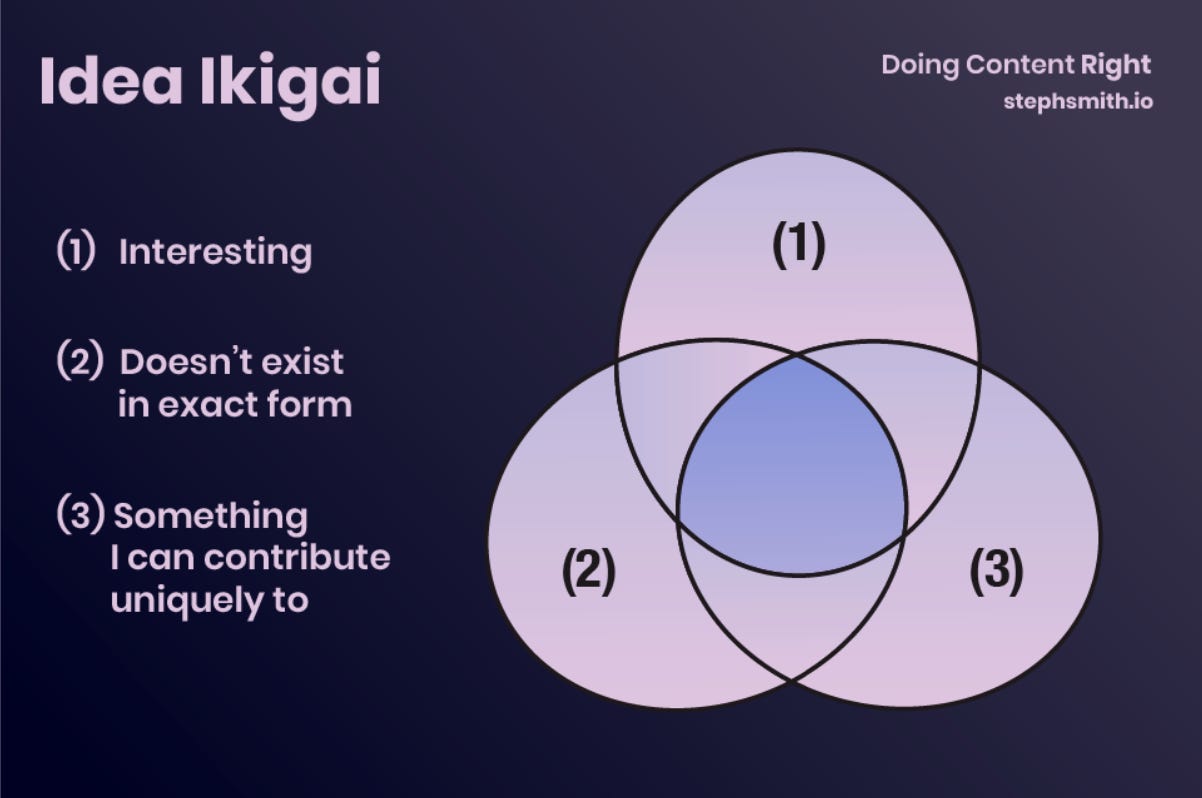How to write content that will skyrocket your personal brand
A four stage guide to start creating content online: set your intentions, choose a niche, platform and distribution method and develop your craft.
Creating content online with the intention of building your personal brand
Today’s newsletter is a somewhat meta topic for me since I’m reviewing my own content creation process. Much like the newsletter about newsletters post.
This is a guide to start writing online for relative newbies to the process.
Over the last few years I’ve written 100+ posts online so whilst I’m focusing on written content other forms of content are obviously available.
Read on for the following:
Who should care — Who this topic is for, when to engage with it and why
How to begin — Setting your goals, focus and a niche
Where to share — Designing a home and distribution process for your content
How to get better — Tips for improvement and refining your content
Who should care about creating content for their personal brand
Anyone who has something to share with the world — either for love or money — should consider creating content. You probably already know if you have an itch to scratch in the realm of content creation. Perhaps you’re already doing it.
Either way, I should start by stating the obvious: I believe that creating content online develops your personal brand.
Having a strong personal brand helps you attract opportunities, sell your services, find work, clients and your tribe. Developing content can grow your personal brand exponentially and at the same time helps you to both find your voice and develop your own line of thinking further. More personal branding tips available from me here.
A (non-exhaustive) list of reasons why may want to create content for your personal brand:
You want to develop expertise/ a brand that will transcend the company you work for if you leave — increasing your employment prospects
You work for a company who will benefit from its team having a public profile (especially true for services likes agencies, VCs, consultancies) to help attract customers or talent.
NB this is an underrated time to start developing your personal brand. People will be interested in what you have to say if your company is doing cool things, and when you aren’t trying to sell them something.You have a company of your own that you are building an audience of loyal fans or customers for
You will one day want to sell a product/service — creating content helps you build authority to an audience more likely to buy from you if they trust you
You want to make money from your writing itself (full or part time)
You have something to share e.g industry insights, to shed light on cause and need a platform for your message
You want to flex a creative muscle and are curious to see what sharing your writing could lead to
Which of these speak to you?
Your reason to want to create content is your ‘why’.
Get really specific about your why.
I have a few whys: to share expertise that develops my authority as a coach (generating clients); to help me solidify what I learn (the generation effect reveals that putting what we know into practice solidifies our knowledge) and one day to drive revenue stream from the content itself.
My three ‘whys’ all lead back to my overall mission with The Ask to support entrepreneurial people’s personal and professional development through content and coaching.
Now you know my why, I implore you to write down your own.
How to begin writing content for your personal brand
With your why in hand, its time to establish the what.
What are you going to write about?
This is often the hardest part.
Almost one year into this newsletter and I’m still refining my content pillars.
It’s an evolving process, but as I say to my clients during any new project or venture, you cannot think your way to an answer, you have to start by doing and the answer will come.
This post about reverse engineering your niche based on your goals sheds some important light about starting with your end goal in mind. The author is referring to his consulting business but the principles remain the same for content.
Your goal dictates your focus area. Work backwards from here.
Writing for creative exploration gives you a more open brief to experiment with; whereas writing for sales requires content about your product or service specifically.
So make sure your why is clear before you decide on your what.
But if you’re like me this still leaves you with a pretty large swathe of things you could feasibly write about.
In this instance, I refer you to this beautiful concept by Steph Smith, the ‘Idea Ikigai’:
In Doing Content Right Steph explains why you shouldn’t just write about anything. You should choose topics which you have a unique vantage point which others do not have, and in a new form or style.
A misconception about niching is that you need to find something where you are the only one talking about it. But the issue here is that can lead to topics with no viable audience, e.g. writing about blue wool knitting is too niche.
Instead focus on bringing together a unique combination of topics. Knitting for kids or for mindfulness, for example.
Seek themes between your disparate interests or a unique angle on one. Steph advises finding three themes you are in the top 20% of knowledge in, which, combined together put you into the top 1%.
I wouldn’t cover startup news for example (a well covered topic) but would delve into the mindset of the people building early stage companies — based on my experience as a startup recruiter and coach.
As Tijmen Rümke wrote in his piece about niching:
“But, remember, that you pick your niche for a reason. You’re picking that niche because doing it gives you the most joy, allows you to work with the best people, and is the area of work that’s most important to you.”
You should be really curious and interested in the topic, as you’ll be writing about it a lot, as the next section explains.
Where to share your written content to develop your personal brand
Hopefully you have an idea on a content focus based on your goals, idea ikigai and interests.
The next stage is getting content out into the big bad world of the internet.
Before we look at the tools to house and distribute your content, here are some principles to bear in mind.
Make quality a priority.
As this Tweet thread from James Clear on his 10th business anniversary suggests, reputation is everything.
Be consistent
Consistency in what you write about (your niche) is as important as when you write about it. Stick to a publishing schedule you can commit to and be consistent. The more frequent the better, but do not compromise quality. This post by Michael Simmons explains why ‘blockbuster’ content aka really great in-depth pieces are a winner even it means lower frequency publishing.
NB I’d argue that when starting out you need to learn enough about your niche and audience before attempting a ‘blockbuster’ so you can iterate faster.Be patience, and stick through the dip
You will encounter resistance whether emotional (fear, procrastination) lack of time or lack of positive feedback. Keep going. You get better the more you post and every ‘failure’ is an opportunity to learn — more on that next. If you have a clear why, goals and niche with research to confirm people are interested in it then you will get there eventually.
With this in mind, you are ready to get practical and share your content.
There are two key aspects to sharing your content: the platform and the distribution.
Sometimes these are one and the same e.g on LinkedIn you can publish content on there (the platform) which gets shared directly with your audience (the distribution).
The same can be said for Substack, since free posts are discoverable without being a subscriber.
However, when you do not own the platform, you are at risk. Risk of the platform changing its cost structure, algorithm or even throwing you off the platform à la Donald Trump.
People who are serious about content distribution know that they should own the platform their content lives on — think of this as buying rather than renting your home.
So examples of this would be a Wordpress website or Ghost domain, where you pay for web hosting a domain name to post your content. This is a part of the internet you own, so long as you are paying for it.
But the issue here is surely obvious: no one is going to visit your website. Not in todays world of information overload. It’s hard enough to get people to read your content when its right in front of them let alone if they have to search and discover it themselves.
So you need some kind of distribution strategy.
You have to generate traffic to come to your digital home, via distribution methods such as social media, email newsletter marketing or publishing platforms like Medium.
Generally speaking, when starting out, pick a platform you own, plus 1-2 distribution channels you enjoy or have experience in. Better to duplicate where it sits both on your owned platform and on a place with more ‘eyeballs’ too.
Content platforms and distribution is a topic in its own right and whilst I’m no expert and am still answering these questions for myself right now, I’m happy to chat through your situation or better yet, hear what is working for you.
How to get better at writing content for your personal brand
The good news is that I don’t believe you need to be a great writer to have an impact creating content online.
It will come more easily of course if writing is one of your strengths but it should not be a barrier to entry.
Depending on your goals you may wish to spend time and money developing the craft of writing with workshops, coaching or training but generally speaking if you are dipping your toe into this world and not expecting immediate pay off then more writing experience itself can be your master. Get going and you’ll see improvements. These newsletters are much quicker and I hope better than when I started out.
So aside from writing more, here are some other routes to improve your process:
Join a community and get feedback from others — There are plenty on this list and I’ll plug my friend’s partner who runs London Writer’s Salon: dedicated writing time weekly for remote groups
Edit well, but separately to your writing — It’s best for you to get everything out of your head first before you go back to make it sound good
Observe other peoples writing— spend time analysing the writing of popular posts (those with lots of likes and shares) and see what trends you can spot
Use writing tools — such as Grammarly the online writing assistant and Readable’s Flesch-Kincaid reading level test to see what reading level you are writing at.
Read widely and often — As author Roz Morris explains in this interview “Reading—the good and the bad—inspires you. It develops your palate for all the tricks that writers have invented over the years. You can learn from textbooks about the writing craft, but there’s no substitute for discovering for yourself how a writer pulls off a trick. Then that becomes part of your experience”
So there we have it, a four stage guide to getting started when you want to create written content and build a personal brand.
I help people develop thought leadership and expertise around their true passions and interests as a coach for people in startups with The Ask.
Get in touch if you think I can help you.
See you in two weeks!
Ellen








